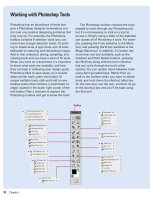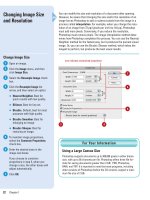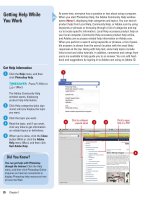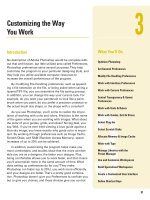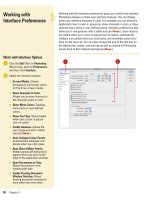Photoshop cs5 by steve Johnson part 23 pptx
Bạn đang xem bản rút gọn của tài liệu. Xem và tải ngay bản đầy đủ của tài liệu tại đây (779.65 KB, 7 trang )
ptg
Working with Adjustment
Layers, Filters, and Tools
Introduction
If you want to visually control an Adobe Photoshop docu-
ment, then adjustment layers are the ultimate tool. The pur-
pose of an adjustment layer is to show how a specific
adjustment, such as Hue & Saturation, changes the appear-
ance of the image. Since the adjustment is contained within a
separate layer, the original image never changes. This gives
you the ability to experiment with different settings. Since
adjustment layers can be saved with the document, you can
close the document, then return at a later time to make fur-
ther adjustments.
Another advantage of adjustment layers is size.
Adjustment layers do not increase the size of a Photoshop
document. Most Photoshop layers are composed of pixels,
so adding traditional layers to a document increases the size
of the file. Since adjustment layers are simply a set of mathe-
matical data, they do not increase the size of the file.
Photoshop has two ways to apply adjustments to an
image. You could go to the Image menu, and choose
Adjustments; however, when you apply an adjustment using
this method, it's permanent. The other way is to use an
adjustment layer—the very definition of control over time.
When working with adjustment layers, you can modify,
merge, or even create a temporary composite image, all
while your original image stays intact. With all of their advan-
tages, you may never perform adjustments using the Image
menu again.
In addition to letting you apply adjustments to an image
without changing the original data, adjustment layers,
because they are separate layers, give you the ability to
apply standard layer controls, such as blending modes, opac-
ity, and fill. Adjustment layers come with their own built-in
masks, and allow you to control how and where the adjust-
ment is applied to the image.
7
7
What You’ll Do
Create an Adjustment Layer
Modify an Adjustment Layer
Merge Adjustment Layers
Create a Temporary Composite Image
Control Adjustment Layers with Clipping
Groups
Delete an Adjustment Layer
Use Blending Modes and Opacity
with Layers
Use Masks with Adjustment Layers
Create Masks with Selections
Retouch Images with Filters
Keep Proper Perspective with
Vanishing Point
Work with the Lens Correction Filter
Retouch Images with Tools and Filters
Control Tonal Range
Work with the Histogram Panel
141
From the Library of Wow! eBook
ptg
142 Chapter 7
Adjustment layers are applied within the Layers panel and use the
Adjustment panel. By default, all layers beneath the adjustment layer
are changed. In addition, adjustment layers will work on any type of
Photoshop layer, including the Background. You can have as many
adjustment layers as you need. For example, you might create a Levels
adjustment layer to control the contrast of an image, and add a Curves
adjustment layer to correct image color. When you create more than
one adjustment layer, each adjustment is applied to the image based on
its stacking order in the Layers panel.
Creating an
Adjustment Layer
Create an Adjustment Layer
Select the Layers panel.
Click the layer you want to adjust.
Click the Create New Fill or
Adjustment Layer button, and then
select from the available types of
adjustment layers.
You can also open the Adjustments
panel to set adjustment settings.
You can choose from 15 icons
representing most of the
adjustment layer options. Below
the icons are a listing of presets
available for some adjustments.
When you click one of the icons,
controls for that type of
adjustment appear on the panel.
Adjust the controls for the specific
adjustment in the Adjustment
panel.
◆ To c hange the focus on t he
panel text boxes (New!), press
Shift+Enter (Win) or Return
(Mac), and then press Tab to
switch between boxes.
At the bottom of the Adjustments
panel, you can use buttons that
allow you to go back to the list of
adjustment types, switch the panel
from Expanded to Standard view,
clip the adjustment to the layer
below, make the layer visible or
invisible, revert to the image state
before adjustment was made,
reset adjustment defaults, or
delete the adjustment.
5
4
3
2
1
1 2
Applying Adjustment Layers
When you apply an adjustment layer to an image, you are no longer
required to save the document in the PSD (Photoshop Document)
format. Photoshop supports saving files with multiple layers, includ-
ing adjustment layers, in the TIFF (Tagged-Image File Format) file
type. The files can be opened just like ordinary TIFF files in standard
layout applications. However, when the file is opened in applications
that support multiple layers, such as Corel Painter or Adobe
InDesign, the adjustment layers are preserved.
For Your Information
3
Adjustments panel
4
5
Presets
From the Library of Wow! eBook
ptg
Chapter 7 Working with Adjustment Layers, Filters, and Tools 143
The beauty of adjustment layers is in the control they offer to the
Photoshop user. When you use the Image menu, and click Adjustments,
any changes made to the image are permanent as soon as you click
OK. But that's not true of adjustment layers. Adjustment layers keep the
changes isolated in a separate layer, and this allows you to modify the
adjustment minutes, or even days later. With this type of creative con-
trol at your fingertips, you can experiment with different settings until
the image looks exactly the way you want.
Modifying an
Adjustment Layer
Modify an Adjustment Layer
Select the Layers panel.
Double-click on the thumbnail of
the adjustment layer you want to
modify.
The options for that specific
adjustment reopens in the
Adjustments panel. If you didn't
already have the Adjustments
panel open, clicking on the layer
you want to modify will open it
automatically. Options for each
type of adjustment dialog box
varies.
Make the changes you want for
the specific adjustment.
Click OK.
4
3
2
1
1
2
3
Did You Know?
You can move adjustment layers up
and down in the layer stack.
Since
each adjustment layer interacts with
other adjustment layers, changing the
order of the layers creates a totally
different image.
From the Library of Wow! eBook
ptg
144 Chapter 7
Photoshop lets you create as many adjustment layers as you need. For
example, you might create a Levels adjustment layer to balance image
contrast, a Curves adjustment layer to correct color, and a Photo Filter
adjustment layer to create an overall warming effect to the image. Each
adjustment layer works with the other adjustment layers to produce the
final image. It's not unusual to have three, four, or even five adjustment
layers controlling a single image. At some point in the design, you might
decide to save space by merging some or all of the adjustment layers.
However, when you merge the adjustment layers, the adjustment
effects are lost, as a result of how Photoshop deals with adjustment
layers. Each adjustment layer controls one specific part of the adjust-
ment, such as Curves or Levels. The layers themselves do not hold an
image; they hold mathematical data on how to change an image. A
single adjustment layer cannot hold more than one set of adjustments.
That's why you have multiple adjustment layers. Merging two or more
adjustment layers together forces Photoshop to discard all of the
adjustment data and the merged adjustment layers turn into one plain
old transparent layer. To solve the problem, try merging the adjustment
layers and the image layer into one single layer.
Merging Adjustment
Layers
Merge Adjustments with Images
Open a document containing an
image layer, and two or more
adjustment layers.
Select the Layers panel.
Click the Layers Options button,
and then select from the following
merge options:
◆ Merge Layers. Merges only the
layers selected in the Layers
panel into a single layer.
◆ Merge Visible. Merges only the
layers that are visible, leaving
the hidden layers untouched.
◆ Flatten Image. Merges all
layers into a flattened
background. If you have one or
more layers hidden, Photoshop
will open a warning dialog box
and ask if you want to discard
the hidden layers.
3
2
1
3
2
Show button
From the Library of Wow! eBook
ptg
Chapter 7 Working with Adjustment Layers, Filters, and Tools 145
When you merge adjustment layers into the image, you wind up with a
single layer that contains all of the adjustments. By merging the adjust-
ment layers, you do lose control over the individual adjustment layers.
It's basically a trade-off of smaller file sizes and less layers to contend
with, but also less control over the image. Let's say you want the best
of both worlds—a single layer that contains the image, all of the adjust-
ments, and the original image with separate adjustment layers. It's pos-
sible; all you have to do is create a composite layer.
Creating a Temporary
Composite Image
Create a Temporary
Composite Image
Open a document that contains
an image, and two or more visible
adjustment layers.
Select the Layers panel, create a
new layer at the top of the layer
stack, and then select it.
Hold down the Alt (Win) or Option
(Mac) key, click the Layers
Options button, and then click
Merge Visible.
Photoshop combines all of the
visible layers into a new layer,
while leaving the original layers
untouched.
3
2
1
2
3
All visible layers
are combined into
the new layer.
Create New
Layer button
Did You Know?
You can use the composite layer
option on any multi-layered Photoshop
document.
Once you've created the
composite layer, you can perform other
adjustments without impacting the
original image, or even drag and move
the composite into another Photoshop
document.
You can use the link option to control
the composite image.
Create a new
layer, and then link the layers you want
included in the composite. Follow the
steps for creating a composite, except
click Merge Linked.
From the Library of Wow! eBook
ptg
146 Chapter 7
When you work with adjustment layers, the adjustments are applied to
all the layers below the adjustment layer, including any additional
adjustment layers. However, there are times when you only want the
adjustment applied to a specific layer. For example, you're working on a
multi-layered document and you create a Curves Adjustment layer for
the purpose of adjusting the color in the next layer down. Unfortunately,
the Curves adjustment is applied to all the layers. The answer is simple;
just create a clipping group to combine the adjustment layer with the
one layer you want to be affected.
Controlling Adjustment
Layers with Clipping
Groups
Control Adjustment Layers with
the Clipping Group Option
Select the Layers panel, and then
click the layer you want to adjust.
Move your cursor down until the
fingertip of the hand pointer
touches the line separating the
adjustment layer from the next
layer down.
Hold down the Alt (Win) or Option
(Mac) key.
The cursor changes from a hand
pointer to a double-circle button
(the clipping group button).
Click your mouse to group the two
layers together.
The thumbnail of the adjustment
layer indents to indicate the two
layers are grouped. The effect of
the adjustment layer impacts the
layer below and no others.
4
3
2
1
1
2
Layers linked as a clipping group
Did You Know?
You can group more than one layer
together.
Hold down the Alt (Win) or
Option (Mac) key, and then click on the
line separating the next layer to add a
layer to the group. To remove a layer
from the group, hold down the Alt
(Win) or Option (Mac) key, and then
click on the line separating two
grouped items.
From the Library of Wow! eBook
ptg
Chapter 7 Working with Adjustment Layers, Filters, and Tools 147
When you delete an adjustment layer you are simply deleting the
adjustment, not the image. Adjustment layers do not contain pixels;
they only manipulate the information contained within the image layer.
Deleting an adjustment layer is as easy as deleting any other layer
type. The effect is the same; the function of the layer is removed from
the document. For example, if you delete a Curves adjustment layer, the
effects are removed and the image returns to its original state. When
you delete an adjustment layer, the change to the image created by the
adjustment layer is removed, and the image returns to its original state.
Deleting an
Adjustment Layer
Delete an Adjustment Layer
Select the Layers panel.
Click the adjustment layer you
want to delete.
Drag the adjustment layer onto the
Delete Layer button.
3
2
1
1
2
The adjustment layer is removed
from the document.
3
Did You Know?
You can convert an adjustment layer
into a regular layer.
By default, adjust-
ment layers come with a built-in mask.
To re move th e mask wh ile pre ser vin g
the adjustment layer, select the adjust-
ment layer in the Layers panel, hold
down the Alt (Win) or Option (Mac)
key, and then click the Delete Layer
button.
From the Library of Wow! eBook

